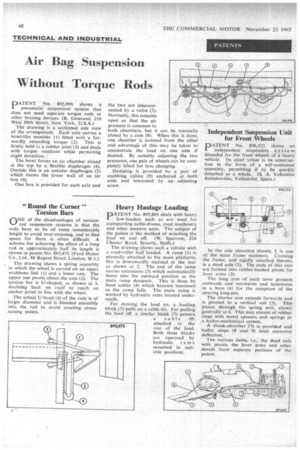Air Bag Suspension Without Torque Rods
Page 50

If you've noticed an error in this article please click here to report it so we can fix it.
PATENT No. 895,996 shows a pneumatic suspension system that does not need separate torque rods or other bracing devices, (R. Gourand, 210 West 88th Street, New York, U.S.A.) The drawing is a sectioned side view of the arrangement. Each axle carries a bowl-like member (I) fitted with a forwardly extending torque (2). This is firmly held LI a rubber joint (3) and deals with torque reactions while permitting slight deviation.
The bowl forms an air chamber closed at the top by a flexible diaphragm (4). Outside this is an annular diaphragm (5) which forms the lower wall of an air box (6).
One box is provided for each axle and the two are interconnected by a valve (7). Normally, this remains open so that the air pressure is common to both chambers, but it can be manually closed by a cam (8). When this is done, one chamber is isolated from the other and advantage of this may be taken to concentrate the load on one axle if desired. By suitably adjusting the two pressures, one pair of wheels can be completely lifted for tyre changing.
Damping is provided by a pair of snubbing cables (9) anchored at both ends and tensioned by an adjusting screw.
Independent Suspension for Front Wheels
PATENT No. 896,322 shows an I independent suspension system intended for the front wheels of a heavy vehicle. Its chief virtue is its construction in the form of a self-contained assembly, permitting it to •be quickly detached as a whole. (S. A. Vehiculos Automoviles, Valladolid, Spain.)








































































































